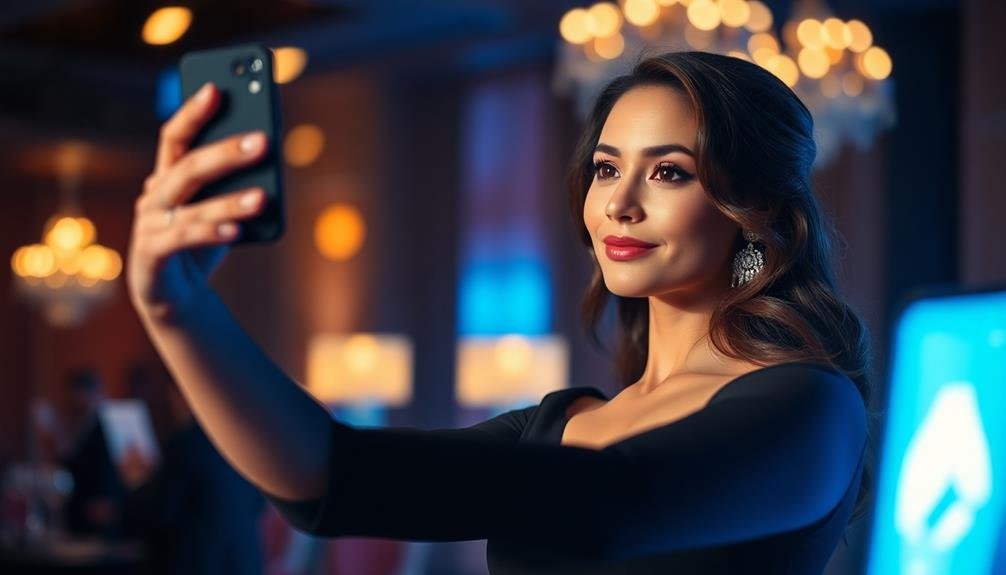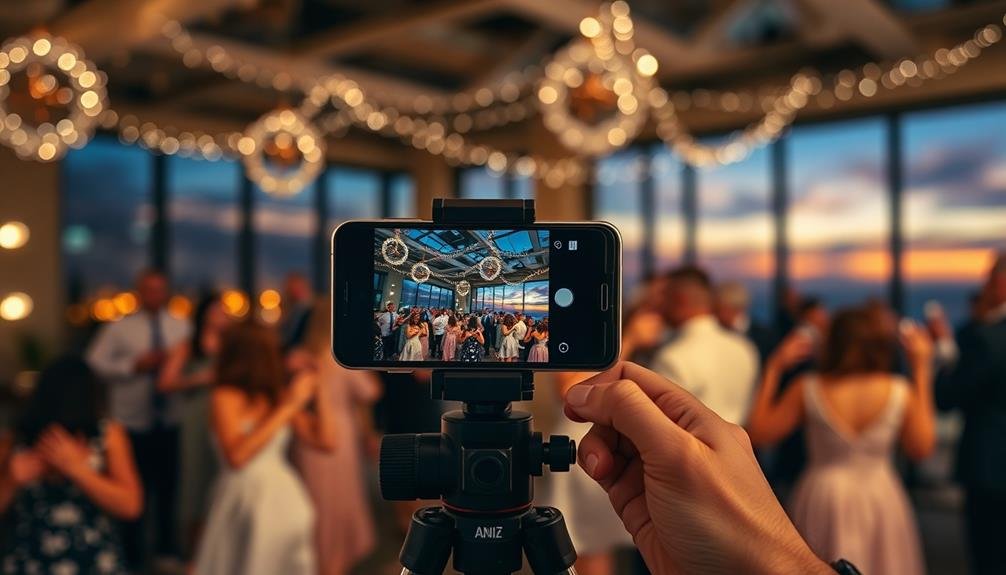Negative space in smartphone photography is a powerful tool to elevate your images. It's the empty area surrounding your main subject, which helps emphasize and draw attention to the focal point. By using negative space effectively, you'll create visually striking compositions that guide the viewer's eye and evoke emotions. It simplifies your shots, reduces distractions, and adds a professional touch to your photos. Negative space also provides room for text overlay, making it ideal for social media content. Whether you're aiming for minimalist aesthetics or looking to tell a story through your images, mastering negative space techniques will transform your smartphone photography. Discover how this simple concept can dramatically improve your visual storytelling.
Understanding Negative Space

Negative space, also known as white space, is the area surrounding the main subject in a photograph. It's the empty or unoccupied space that helps define and emphasize the primary focus of your image. When you're composing a shot, you'll want to pay attention to both the subject and the space around it.
Understanding negative space is essential for creating balanced and visually appealing smartphone photos. It's not just about what you include in the frame, but also what you leave out. By incorporating ample negative space, you can draw attention to your subject and create a sense of simplicity or minimalism in your images.
Negative space doesn't have to be white or empty. It can be a clear sky, a plain wall, or even a blurred background. The key is that it's less visually busy than the main subject.
When you're framing your shot, look for areas of simplicity that can complement your subject. By mastering the use of negative space, you'll be able to create more impactful and professional-looking smartphone photos.
Creating Visual Balance

When you use negative space effectively, you'll naturally emphasize your subject's importance in the frame.
This technique allows you to guide the viewer's eye directly to the main focal point of your smartphone photo.
Emphasizing Subject Importance
Creating visual balance through negative space is a powerful tool for emphasizing your subject's importance in smartphone photography. By surrounding your main subject with empty space, you'll draw the viewer's eye directly to what matters most in your image. This technique helps create a clear focal point and reduces distractions, allowing your subject to stand out prominently.
To emphasize subject importance, try positioning your main subject off-center and leaving ample space around it. This approach creates tension and interest while highlighting the subject's significance. You can also use leading lines or patterns in the negative space to guide the viewer's gaze towards your subject.
Experiment with different compositions to find the most effective balance. Sometimes, a minimalist approach with vast negative space can make your subject appear more dramatic or isolated.
In other cases, strategically placed elements in the negative space can provide context or tell a story while still maintaining focus on the main subject.
Guiding Viewer's Eye
Visual balance through negative space not only emphasizes your subject but also serves as a powerful tool for guiding the viewer's eye. When you incorporate ample negative space in your smartphone photos, you're creating a visual pathway that naturally leads the viewer's gaze to the main subject. This technique is particularly effective when you place your subject off-center, following the rule of thirds.
By strategically positioning your subject and leaving open space around it, you're inviting the viewer to explore the entire composition. The negative space acts as a buffer, allowing the eye to rest before focusing on the main element.
You can use this technique to create a sense of movement or direction within your image. For instance, if your subject is looking or moving towards the empty space, it creates a natural flow that the viewer's eye will follow.
Experiment with different compositions to see how negative space affects the viewer's perception. You'll find that by manipulating the empty areas in your frame, you can control where the viewer looks first and how their gaze travels through the image, ultimately enhancing the overall impact of your smartphone photography.
Emphasizing Your Subject

Negative space can be a powerful tool to draw attention to your subject effortlessly.
By surrounding your main subject with ample empty space, you'll create a visual impact that immediately captures the viewer's eye.
You'll find that this technique not only emphasizes your subject but also adds a sense of sophistication and clarity to your smartphone photographs.
Draw Attention Effortlessly
Attention-grabbing smartphone photos often rely on the power of negative space to emphasize their subjects. By strategically incorporating empty areas around your main subject, you'll effortlessly draw the viewer's eye to the focal point of your image. This technique creates a visual hierarchy, making it clear what's important in your composition.
When using negative space, you'll find that:
- It simplifies your image, reducing distractions
- It creates a sense of balance and harmony
- It evokes emotions like calmness or isolation
To effectively use negative space, look for clean backgrounds or expansive areas like open skies, blank walls, or empty fields.
Position your subject off-center, allowing the surrounding emptiness to frame and highlight it. You can also experiment with different angles to maximize the empty space around your subject.
Create Visual Impact
Three key elements contribute to creating visual impact through negative space in smartphone photography. First, contrast amplifies your subject's prominence. By surrounding your main subject with a stark, empty background, you'll make it stand out dramatically. Second, simplicity enhances the overall composition. Removing distracting elements allows viewers to focus solely on what matters most in your image. Third, proportion plays an essential role in balancing your composition. Experiment with different ratios of negative space to subject size to achieve the desired effect.
To maximize visual impact, consider these techniques:
| Technique | Effect | Example |
|---|---|---|
| Minimalism | Emphasizes subject | Single flower in vast field |
| Scale | Creates depth | Tiny person against expansive sky |
| Framing | Directs attention | Subject framed by architecture |
When applying these techniques, don't be afraid to push boundaries. Try unconventional compositions, like placing your subject at the edge of the frame or using extreme proportions of negative space. Remember, the goal is to create a striking image that captures attention and conveys your intended message effectively. With practice, you'll develop an intuitive sense of how to use negative space to create powerful, visually impactful smartphone photographs.
Evoking Emotion and Mood

Emotions surge through powerful photographs, and negative space plays a crucial role in setting the mood. By strategically incorporating empty areas, you can evoke specific feelings in your viewers. A lone subject surrounded by vast emptiness can create a sense of isolation or contemplation. Conversely, a subject placed at the edge of the frame with ample negative space can suggest freedom or opportunity.
Consider how different emotions can be triggered by manipulating negative space:
- Serenity: Use expansive, uncluttered backgrounds to create a calm, peaceful atmosphere.
- Loneliness: Isolate your subject within a large area of negative space to emphasize solitude.
- Excitement: Employ dynamic angles and unconventional framing to generate energy.
The color and texture of the negative space also contribute to the overall mood. Soft, muted tones can evoke melancholy or nostalgia, while bold, contrasting colors may inspire joy or excitement.
Experiment with various compositions to find the perfect balance between your subject and the surrounding negative space. This interplay will help you create smartphone photographs that not only capture attention but also resonate emotionally with your audience, leaving a lasting impression.
Minimalist Aesthetics in Photography

Minimalist aesthetics in photography harness the power of negative space to create striking, impactful images. By embracing simplicity and focusing on essential elements, you can produce visually compelling compositions that draw viewers' attention to your subject.
To achieve a minimalist look, start by decluttering your frame. Remove distracting elements and focus on a single, strong subject. Use negative space strategically to isolate your subject and create a sense of balance. This approach can make your images feel more powerful and thought-provoking.
Experiment with different ratios of subject to negative space. You'll find that even small subjects can have a big impact when surrounded by ample empty space. Play with symmetry and asymmetry to create interesting visual tensions.
Consider using plain backgrounds like clear skies, blank walls, or smooth water surfaces to emphasize your subject. Monochromatic color schemes can also enhance the minimalist feel of your photos.
Negative Space for Text Overlay

In light of the growing trend of sharing photos on social media, negative space in smartphone photography can be particularly useful for text overlay.
When you create images with ample negative space, you're providing a perfect canvas for adding captions, quotes, or other text elements. This technique is especially valuable for businesses, influencers, and content creators who want to convey messages alongside their visuals.
To effectively use negative space for text overlay:
- Choose a simple background that contrasts with your text color
- Position your main subject off-center to leave room for text
- Consider the orientation of your image and how text will fit
Composition Tricks With Negative Space

Mastering negative space in smartphone photography opens up a world of creative composition possibilities. You can use it to create striking visual contrasts, draw attention to your subject, and evoke powerful emotions. Try framing your subject against a vast, empty sky or positioning it at the edge of the frame, leaving ample space on one side. This asymmetry can create tension and intrigue in your images.
Here's a quick guide to some effective negative space techniques:
| Technique | Effect | Best For | Avoid |
|---|---|---|---|
| Rule of Thirds | Balanced composition | Landscapes, portraits | Centered subjects |
| Leading Lines | Directs viewer's eye | Urban scenes, roads | Cluttered backgrounds |
| Minimalism | Emphasizes subject | Product shots, abstracts | Busy environments |
| Silhouettes | Creates mystery | Sunsets, architecture | Complex subjects |
Experiment with these techniques to add depth and interest to your smartphone photos. Remember, negative space isn't just empty area; it's an active element in your composition. Use it to tell a story, create mood, or highlight your subject in unexpected ways. Don't be afraid to push boundaries and break traditional composition rules for unique, eye-catching results.
Practicing Negative Space Techniques

Now that you're familiar with negative space techniques, it's time to put them into practice. Start by identifying subjects in your everyday environment that lend themselves to negative space compositions. Look for simple, recognizable shapes against clean backgrounds.
Try photographing:
- A lone tree against a clear sky
- A solitary person walking on an empty beach
- A brightly colored object on a plain surface
As you frame your shots, experiment with different ratios of subject to negative space. Remember, the goal is to create a balance that draws attention to your main subject while using the surrounding emptiness to enhance the overall composition.
Don't be afraid to get creative with your smartphone's camera settings. Use portrait mode to blur the background, creating a more pronounced negative space effect.
Play with exposure compensation to adjust the brightness of your negative space, making it lighter or darker to achieve your desired look.
Practice regularly, and soon you'll develop an eye for spotting negative space opportunities in your daily life. As you refine your skills, you'll find that incorporating negative space can dramatically improve the impact and visual appeal of your smartphone photos.
Frequently Asked Questions
How Does Negative Space Affect the File Size of Smartphone Photos?
Negative space doesn't directly impact file size in smartphone photos. You'll find that file size depends on factors like resolution, compression, and image complexity. However, simpler compositions with more negative space may compress slightly better.
Can Negative Space Be Used Effectively in Portrait Mode Photography?
You can definitely use negative space effectively in portrait mode. It'll draw attention to your subject, create a sense of calm, and add visual interest. Try positioning your subject off-center and leave plenty of empty space around them.
Are There Apps Specifically Designed to Enhance Negative Space in Photos?
You'll find several apps designed to enhance negative space in photos. They offer tools like cropping, background removal, and filters. Try VSCO, Snapseed, or Adobe Lightroom Mobile for powerful editing features that'll help you emphasize negative space effectively.
How Does Negative Space Impact Social Media Engagement for Smartphone Photos?
You'll find that negative space in your smartphone photos can greatly boost social media engagement. It draws attention to your subject, creates a cleaner look, and allows for easier text overlay, making your images more shareable and eye-catching.
What Are Common Mistakes Beginners Make When Incorporating Negative Space?
You're likely to overdo it, filling too much space or choosing distracting backgrounds. You might also forget to take into account balance, place subjects awkwardly, or neglect the rule of thirds. Don't rush it; practice makes perfect.
In Summary
You've now got the tools to harness negative space in your smartphone photography. It's a powerful technique that'll transform your images. Remember, it's not just about what you include, but also what you leave out. As you practice, you'll find that negative space can create balance, emphasize subjects, and evoke emotions. Don't be afraid to experiment with minimalist compositions and leave room for text. Your smartphone photos will stand out with these newfound skills.





Leave a Reply